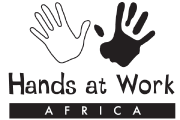Session Two | Who is Hands at Work?
(Length: 70 minutes)
Story & Prayer
(10 minutes)
Begin by sharing the story of a child or Care Worker and praying.
Who We Are
(15 minutes)
Review and discuss George & Carolyn’s story
What struck you about their story?
What elements of their story have significantly influenced Hands at Work?
An important part of understanding Hands at Work is understanding all the layers of people who make up Hands at Work and how each layer is necessary in strengthening the ministry. This illustration will be helpful to print and keep with you for reference throughout your preparation, as well as while on the ground in Africa.
-
Draw out important takeaways and foundational themes. For example:
“I grew up a ‘Christian’,” George says, “but this time I met Jesus face to face!” He wasn’t seeking Christ, but when He burst into George’s life he was completely transformed.
He walked with a black pastor named Hezekiah – learning from the local church.
George and Carolyn decided to give up their comfortable existence.’ – the cost of following Jesus and being involved in this work.
Using the most basic local transport and often travelling on foot through Southern Africa: South Africa, Zimbabwe, Mozambique, Malawi and Zambia. Staying in impoverished villages’ – the DNA of Hands at Work: simple, personal, close to the ground.
He submitted to and was discipled by a Zulu woman – breaking down barriers, counter-cultural, taught servanthood, relationships, making it personal.
Ministry is not only to the church within Africa but to the church outside Africa.
What We Do
(30 minutes)
What makes Hands at Work unique is an unwavering commitment to these values and practices:
Poorest of Poor
Local Community Ownership
Relationships
3 Essential Services
Have you heard these terms before? What do you know about them? Have you seen them in action?
Kristal Hoff, Canadian Volunteer, explains in this video (5:40) about how these pillars of Hands at Work’s model inform the ministry and play out practically in communities.
Now let’s consider all we’ve heard and learned, and go to a community in Africa to see it illustrated. Watch this video of the story of Gogo Belita (4:09) and her grandchildren, Exhildah and Mary. Keep in mind some of what you’ve already learned and try to name and locate these concepts and people throughout the story:
Poorest of Poor Local | Community Ownership | Relationships | 3 Essential Services | Vulnerable Child | Primary Caregiver | Care Worker | Local Church | Community Based Organisation | Hands at Work Local Office | International Church/Partner
DISCUSSION
Take some time to discuss this story. Don’t feel the need to work through all of these questions, but let them guide you through important takeaways from the story.
Where do you see the poorest of the poor, local community ownership and relationships in the story?
What factors make Gogo Belita and her grandchildren vulnerable? Consider the seen and unseen.
How do you see the layers of relationships interacting to care for this family? Reference your ‘Layers of Hands illustration’. Do you see yourself in these layers of relationships?
In the poorest of the poor communities, local community ownership and relationships take time to strengthen and mature, which means they are very fragile
Can you think of practices that threaten to disrupt these important elements?
As visitors we can be at risk of coming with ideas and solutions. How do we, at times, contribute to unhelpful or unhealthy practices? (e.g. gift giving)
How do our tendencies to fix or create short cuts affect how we see ourselves, others and God?
How can we prepare ourselves to participate well in supporting the work to strengthen these important values and practices?
Logistics
(15 minutes)
What do we need to know?
Homework
Learn about the history and current prevalence of HIV/AIDS in the country you are visiting by exploring that country’s profile on AVERT’s resource webpage: https://www.avert.org/professionals/hiv-around-world/sub-saharan-africa.






